
We offer the best-in-class Digital Marketing solutions to cater your brand and business needs. At Seolift, we have a team of experts who provide you with top notch digital marketing services. Our premium services include SEO, PPC, SMM and Content Marketing.
Pay-per-click (PPC) advertising has revolutionized the world of digital marketing, offering businesses an effective way to reach their target audience and drive relevant traffic to their websites. With the increasing competition in the online landscape, measuring the return on investment (ROI) in PPC advertising has become crucial for businesses.
It evaluates the success and profitability of their campaigns. To understand ROI comprehensively, tracking and analyzing key metrics that provide valuable insights into campaign performance and help optimize strategies for maximum results is essential.
This blog will explore the intricacies of measuring ROI in Pay Per Click advertising and the key metrics businesses need to track. By understanding these metrics and their significance, you can gain actionable insights to refine your campaigns, make data-driven decisions, and achieve better ROI in your PPC advertising efforts.
Click-through rate (CTR) calculates the percentage of people who click on your PPC ad after viewing it. It is a significant metric to gauge the ad’s relevancy and appeal to the target audience. A high CTR denotes that your ad is capturing attention and generating interest. By continuously monitoring and optimising your ad copy, keywords, and targeting, you can improve your CTR and increase the likelihood of driving more qualified traffic to your website.
The conversion rate evaluates the percentage of organic website visitors who complete a desired step, such as purchasing, filling out an online website form, or subscribing to a newsletter. It directly reflects the effectiveness of your PPC campaign in driving practical steps. By tracking the conversion rate, you can identify underperforming landing pages, optimize your call-to-action, and refine your targeting to improve the overall ROI of your PPC advertising efforts.
Cost per click (CPC) is the amount you pay each and every time a visitor clicks on your PPC ad. Tracking your CPC is essential for monitoring your advertising budget and ensuring cost efficiency. Optimizing your keywords, ad quality, and bidding strategies can reduce your CPC and maximize the impact of your PPC campaigns. A lower CPC allows you to generate more clicks and conversions while keeping your advertising costs in check.
Cost per conversion (CPA) measures the average cost incurred to acquire a conversion, such as a sale or lead. It provides beneficial insights into the efficiency of your PPC campaigns and allows you to evaluate their profitability. By tracking your CPA, you can identify areas where your campaigns perform well and allocate your budget accordingly. Lowering your CPA requires continuous optimization of keywords, ad targeting, landing pages, and ad messaging to ensure maximum return on investment.
Return on ad spend (ROAS) is a metric that compares the revenue generated from your PPC campaigns to the amount spent on advertising. It helps you comprehend the effectiveness of your campaigns in generating revenue. By calculating ROAS, you can identify which campaigns, keywords, or ad groups deliver the highest return on investment. This insight allows you to allocate your advertising budget more effectively, focusing on the most profitable areas of your PPC campaigns.
While not a PPC-specific metric, considering your customers’ lifetime value (LTV) is crucial when measuring ROI in PPC advertising. LTV refers to the total revenue a user generates over the entire relationship with your business. By analyzing the LTV, you can assess the long-term profitability of your PPC campaigns. Understanding each customer’s value lets you make informed decisions about campaign optimization, bidding strategies, and customer retention efforts.
Quality Score is a metric used by online search engines like Google to assess the quality and relevance of your PPC ads and landing pages. It considers click-through rate, ad relevance, and landing page experience. A higher Quality Score can be a leading cause to lower CPC and higher ad positions, ultimately improving the ROI of your PPC campaigns. By continuously optimizing your ads and landing pages to improve your Quality Score, you can increase the effectiveness and cost-efficiency of your PPC advertising efforts.
Return on Investment (ROI) is the ultimate metric for evaluating the success and profitability of your PPC campaigns. It calculates the net profit generated as a result of your advertising investment. You can determine your PPC campaigns’ value and effectiveness by comparing the revenue generated against the total advertising costs. Tracking ROI helps you identify campaigns, keywords, or ad groups that deliver the highest return on investment, enabling you to allocate resources effectively and optimize your campaigns for maximum profitability.
Measuring ROI in pay-per-click (PPC) advertising is a critical step in evaluating the success and profitability of your campaigns. By tracking key metrics like CTR, conversion rate, cost per click (CPC), cost per conversion (CPA), return on ad spend (ROAS), and quality score and considering the lifetime value (LTV) of customers; companies can attain valuable insights into the performance and effectiveness of their PPC campaigns.
We offer the best-in-class Digital Marketing solutions to cater your brand and business needs. At Seolift, we have a team of experts who provide you with top notch digital marketing services. Our premium services include SEO, PPC, SMM and Content Marketing.
